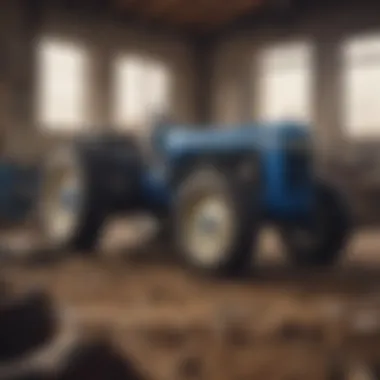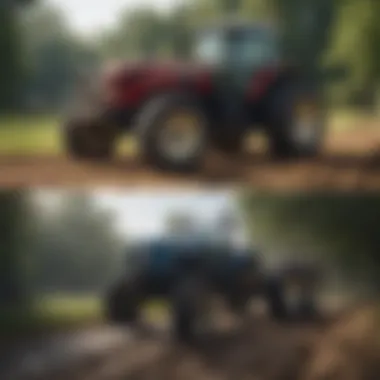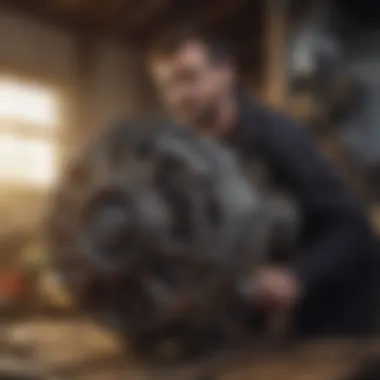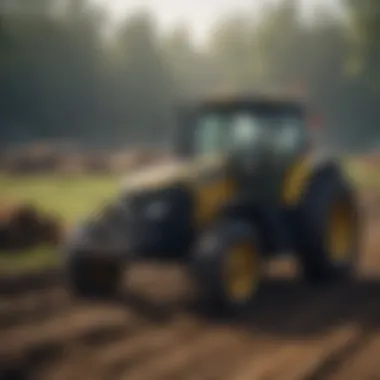Exploring Salvage Parts for New Holland Tractors


Intro
In the ever-evolving landscape of agriculture, the reliance on machinery such as New Holland tractors is paramount. These tractors serve as the backbone for many farming operations, ensuring productivity and efficiency. However, as these machines endure wear and tear over time, the demand for reliable parts becomes critical. This article seeks to shed light on the realm of salvage parts, which not only serves as a cost-effective alternative but also promotes sustainability in farming practices.
The significance of utilizing salvage parts cannot be overstated. These components not only assist in maintaining equipment but also contribute to a circular economy, reducing waste and encouraging resourcefulness among farmers. By integrating salvage parts into their operations, farmers can achieve considerable cost savings and ensure that their machinery operates at optimal levels.
This narrative is structured to provide insights into the importance of salvage parts for New Holland tractors, while also offering an overview of the practices involved in sourcing and utilizing these components effectively.
Prelude to New Holland Tractors
Understanding New Holland tractors provides farmers and enthusiasts with crucial insights into one of the most significant brands in agricultural machinery. New Holland has cultivated a reputation for quality, reliability, and innovation over the decades. This importance is highlighted when discussing salvage parts. Farmers relying on New Holland tractors can benefit immensely from a thorough knowledge of this brand. It influences choices when sourcing salvage parts effectively and can lead to substantial cost savings.
Overview of New Holland as a Brand
New Holland Agriculture represents a division of CNH Industrial, which has global influence in the agricultural sector. The brand is known for producing a diverse range of equipment, from tractors to combine harvesters. Farmers often gravitate towards New Holland because of their commitment to research and technology, which enhances agricultural productivity. The distinct blue color signifies not only the brand identity but also promises quality manufacturing and customer service.
New Holland has consistently positioned itself as a leader in the development of farmer-driven technology. This means products are often better suited to meet specific farming needs. Many farmers advocate for New Holland due to their efficiency and the support network established for owners. Knowing the advantages offered by New Holland can help in making informed decisions around equipment maintenance, especially regarding salvage parts.
Historical Development and Impact
The inception of New Holland dates back to 1895, with roots in a small Pennsylvania community. Since then, it has undergone significant transformation, from a simple manufacturing operation to a major global player in agro-tech. The company's history reflects a continuous commitment to improving farming practices.
The introduction of pioneering agricultural technologies such as the New Holland 720 baler showcased innovation, offering farmers game-changing tools. Today, they are renowned for their commitment to sustainable farming solutions, which resonate strongly with environmentally conscious farmers.
The legacy of New Holland is not merely about machinery but catalyzing change in agricultural practices. The influence is evident in how tractors are utilized on modern farms, reflecting advancements that have made their machines popular in various regions.
Additionally, New Holland tractors have adapted to the needs of farmers by offering different models tailored for specific agricultural tasks. This has ensured that as farming practices evolve, New Holland remains at the forefront.
In summary, understanding the brand's legacy and current relevance aids in recognizing the importance of salvage parts. These parts not only ensure the longevity of New Holland tractors but also support a movement towards more sustainable farming methods.
The Role of Salvage Parts in Agriculture
The role of salvage parts is significant in the agricultural sector. These parts are crucial for the repair and maintenance of essential machinery, commonly utilized by farmers. This section explores their definition, importance, and the reasons why farmers increasingly opt for these alternatives over brand new components. By understanding these aspects, farmers can make informed decisions regarding their equipment needs and budgets, ensuring the sustainability and efficiency of their operations.
Definition and Importance of Salvage Parts
Salvage parts, often referred to as used or recycled parts, are components reclaimed from machinery that is no longer operational. These parts can include anything from engines, transmissions, to smaller electrical components. Understanding their importance is critical. Salvage parts reduce the costs of repairs significantly, as they can be obtained at a fraction of the price of new parts.
Moreover, using salvage parts promotes a circular economy. Instead of discarding old machinery, which may still hold value, farmers can utilize these components to extend the life of their older models. This not only conserves resources but also reduces overall waste, aligning with environmental sustainability in agriculture. By sourcing salvage parts, farmers can maintain their equipment more economically, thus enhancing operational efficiency.
Reasons Farmers Opt for Salvage Parts
There are several reasons farmers lean towards using salvage parts:
- Cost Savings: Salvage parts typically cost much less than brand new components. For many farmers, who often operate under tight budgets, opting for salvage can mean substantial savings.
- Availability: Certain models of tractors or machinery may have been discontinued, making it difficult to find original parts. Salvage yards often have what farmers need, providing a reliable source for hard-to-find items.
- Quality Options: Many salvage parts come from higher-quality equipment that has been well maintained. This can result in getting good-quality components at a reduced price.
- Environmental Consciousness: Farmers are increasingly aware of their environmental footprint. Using salvage parts contributes to reducing waste and promotes sustainability in farming practices.
By understanding the crucial role of salvage parts, farmers can leverage these resources effectively. Properly sourced and maintained salvage parts can keep machinery operational longer, showcasing their value in daily agricultural practices.
Identifying Quality Salvage Parts


The process of identifying quality salvage parts is paramount in ensuring optimal performance and longevity of New Holland tractors. Salvage parts can deliver significant savings when compared to new components. However, the effectiveness of these parts hinges on their quality and reliability. Poorly sourced or defective salvage parts can lead to equipment failure, which can disrupt farm operations and result in costly downtime. For this reason, understanding how to evaluate and select salvage parts is crucial for any farmer or enthusiast.
Inspection and Assessment Techniques
Before purchasing salvage parts, it is vital to conduct thorough inspections. Start with a visual assessment. Look for signs of wear, rust, or damage. These physical indicators can be quite telling about the part's condition. For instance, cracked or corroded metal components may not perform well in the long term.
Additionally, performing functional tests, if possible, can provide insight into the part's reliability. For electrical components, conducting a continuity test can determine if they conduct electricity as they should. Always ask for maintenance records or service history when available; this can highlight how well the part was cared for in its previous use.
Consider adopting a standard assessment checklist:
- Visual Inspection: Check for visible damage or excessive wear.
- Functional Testing: Test components where feasible.
- Documentation Check: Request service records.
- Professional Evaluation: Consult an expert if unsure about a part’s condition.
"Quality salvage parts not only reduce costs but also improve farm productivity when properly identified and assessed."
Sourcing Reliable Salvage Parts Suppliers
Finding a reliable supplier is a critical step in sourcing salvage parts. Not all suppliers practice the same level of quality control. Start by researching local salvage yards that specialize in agricultural equipment. Look for companies known for their reputation and positive customer feedback.
Consider the following when selecting a supplier:
- Reputation: Investigate reviews and ask fellow farmers about their experiences.
- Inventory Variety: A broader selection indicates a more established supplier.
- Transparency: Good suppliers will provide clear information about parts, including their origin and history.
- Warranty: Check if they offer any guarantee or return policy on their parts. This can provide an extra layer of security.
Engaging with community forums such as reddit.com can also yield valuable recommendations and experiences from other farmers. Making connections in these networks often uncovers hidden gems among suppliers who may not advertise widely.
Key Salvage Parts for New Holland Tractors
Understanding key salvage parts specific to New Holland tractors is crucial for farmers and agricultural enthusiasts. These parts play a significant role in both the efficiency and longevity of the machinery. Salvage parts can reduce repair costs, decrease downtime, and promote sustainable farming practices. By using salvaged components, operators can keep their tractors running in optimal condition while being mindful of the environmental impacts.
Engines and Transmissions
Engines and transmissions are among the most vital systems of any tractor. Salvaged engines can offer a cost-effective solution when replacements are necessary. These parts often come tested and hold performance standards similar to new units. Save on labor and parts costs while ensuring your tractor has the power to operate efficiently.
Similarly, salvaged transmissions can extend the life of the tractor without breaking the bank. They can restore the gear-shifting efficiency and are suitable for a variety of models. However, meticulous inspection is required to confirm their performance before installation.
Hydraulic Systems and Components
Hydraulic systems are integral to the performance of New Holland tractors, controlling the lift systems and steering mechanisms. Salvaged hydraulic pumps, hoses, and cylinders can perform just as well as new parts when sourced from reputable suppliers. These components can be less expensive, facilitating repair without disproportionate costs.
Farmers should always look for signs of wear in salvaged hydraulic components. Checks for leaks and performance under pressure are essential to ensure reliability, as the entire hydraulic system’s function relies heavily on each part.
Electrical Systems and Wiring
Electrical systems and wiring can be particularly challenging to maintain. Issues in this area can lead to significant operational problems, affecting everything from starting the engine to running attached implements. Salvaged wiring harnesses and electrical components provide an attractive solution when repairs are needed.
Using quality salvaged electrical parts can save money and reduce the time your tractor spends out of service. However, ensuring the compatibility of these components with your tractor model is imperative. Inspecting the insulation, connectors, and overall condition can help prevent future electrical failures.
Chassis and Structural Parts
The chassis and structural parts are crucial for the overall integrity of New Holland tractors. Salvaged chassis can be an economical choice for replacement, offering structural durability that is often just as reliable as new. Components like frames and axles that undergo rigorous assessment can ensure enhanced strength and stability for ongoing agricultural work.


Salvaged structural parts reduce waste and reuse materials that might otherwise contribute to landfills. This aspect ties back to sustainability, as an increasing number of farmers look for environmentally responsible options. Proper evaluation, including checks for rust and fatigue, should accompany every salvage purchase in this category.
Benefits of Using Salvaged Parts
Using salvage parts in agriculture is a topic of growing significance. It addresses both financial and environmental concerns. For farmers, especially those operating New Holland tractors, salvaged parts offer solutions that align with sustainable practices and budget-conscious operations. Understanding the benefits is crucial, as these components can affect the longevity and efficiency of farming equipment.
Cost Efficiency in Repairs and Maintenance
One of the primary advantages of utilizing salvage parts is the potential for cost savings. New Holland tractor components can be expensive when bought new. Salvaged parts often come at a fraction of the cost. This cost efficiency reduces the financial burden on farmers, allowing them to allocate their resources to other essential areas of their farm operations.
When considering repairs and maintenance, the use of salvaged components can lower overall operational expenses. For instance, a farmer might obtain a used hydraulic pump or transmission at a lower price compared to purchasing a brand new counterpart.
"Farmers can significantly cut down their repair costs by choosing salvaged parts, making it a pragmatic choice for maintaining equipment."
However, cost is not the only consideration. Farmers should assess the condition of salvaged parts before purchase. Conducting inspections or sourcing from reputable suppliers can ensure that the parts will function effectively and minimize the chances of future breakdowns.
Reduction of Environmental Impact
Sustainability is another critical aspect associated with salvaged parts. In agriculture, particularly, reducing the environmental footprint is essential. By opting for salvaged components, farmers can decrease waste and diminish the demand for new materials. The production of new tractor parts often involves resource-intensive processes that contribute to pollution and deplete natural resources.
Using salvaged parts not only utilizes existing materials but also reduces the energy consumption associated with manufacturing new parts. This approach aligns with a broader trend towards environmentally responsible farming practices.
Key considerations include:
- Waste Reduction: Salvaging parts diverts materials from landfills, contributing to lower waste levels.
- Resource Conservation: Less demand for raw materials translates to diminished resource extraction and use.
- Lower Carbon Footprint: Reduced manufacturing needs result in fewer greenhouse gas emissions.
In summary, embracing salvage parts presents a dual benefit of economic advantages and environmental stewardship. As farmers navigate the complexities of modern agriculture, these elements become essential components of their strategic planning.
Challenges of Salvage Parts Usage
Using salvage parts in agricultural machinery, especially New Holland tractors, presents notable challenges. Understanding these challenges is crucial for farmers and machinery enthusiasts who want to maximize efficiency and minimize risks. A deep dive into potential quality issues and regulatory compliance can help mitigate these challenges.
Potential Quality Issues
Quality is a primary concern when using salvage parts. The condition of these parts can vary widely. Some components may be nearly new, while others can show significant wear and tear.
Farmers must consider the following factors:
- Inspection: Each salvage part requires thorough inspection before purchase. Look for visible signs of damage or excessive wear.
- Provenance: Knowing the source is crucial. Parts from reputable dismantlers tend to have better quality and more thorough inspections.
- Compatibility: Salvage parts must match the specific model of the tractor. Mismatched components can lead to further issues down the line.
“The risk of installing a low-quality salvage part can outweigh the initial cost savings.”
It's essential to establish a balance between cost and reliability. Investing in quality salvage parts may prevent future expenses from repairs or replacements.
Regulatory Compliance and Liability
In many regions, using salvaged parts raises questions of regulatory compliance. Familiarity with local laws regarding the use of salvage parts is essential.
Some key points to consider include:


- Warranty Considerations: Installing salvaged parts can void warranties from manufacturers. Understand what your original warranty covers before opting for salvage.
- Safety and Standards: Some jurisdictions have safety standards that salvage parts must meet, particularly for agricultural equipment. Non-compliance can lead to penalties or disqualification for use in certain operations.
- Liability: If a salvage part fails and causes an accident or damage, liability can fall on the user. This emphasizes the importance of purchasing from credible suppliers who can provide necessary documentation and guarantees regarding part quality.
Navigating these challenges requires diligence and careful planning. For farmers, weighing the benefits against potential drawbacks is key to making informed decisions regarding salvage parts.
Future Trends in Tractor Salvage Parts
The landscape of tractor salvage parts is evolving. With advancements in technology and shifting market dynamics, farmers and businesses must stay informed. Understanding these trends can lead to better decisions in sourcing parts and maintaining equipment. The future of salvage offers potential benefits that can influence overall efficiency and sustainability in agriculture.
Emerging Technologies in Salvage Operations
Technology is reshaping the way salvage operations function. New Holland tractors, like other agricultural machinery, benefit from this shift. Enhanced systems for tracking salvage parts enable more accurate inventories. Online platforms are facilitating smoother connections between farmers and salvage suppliers. These technologies make it easier to find specific parts, reducing time and effort.
Artificial Intelligence (AI) is also making its mark. AI-driven analytics can forecast demand for specific salvage parts, helping suppliers optimize their inventory. In addition, automation in salvage yards can streamline operations. This leads to quicker processing of parts and improved accuracy in quality control. Farmers are likely to see a more efficient supply chain as these technologies become commonplace.
Market Predictions for Salvaged Agricultural Parts
Market trends indicate a growing demand for salvaged parts. As agriculture evolves, the industry faces disruptions that reshape equipment purchasing decisions. Economic pressures are encouraging farmers to look for cost-effective solutions. Salvaged parts represent a viable option. Moreover, as awareness of sustainability grows, more operators are drawn to salvage parts due to their reduced environmental impact.
Analysts predict increased investments in recycling and refurbishing existing parts. This is because farmers want reliability alongside cost savings. The future may see an expanding network of suppliers specializing in salvaged parts. Such a network would enhance competition, potentially leading to improved quality and lower prices.
"The shift from new parts to salvaged alternatives reflects a broader trend towards sustainability in agriculture."
Practical Tips for Farmers
Maintaining and optimizing the use of salvage parts is crucial for farmers who rely on New Holland tractors. This section aims to provide practical strategies that can guide users in efficiently integrating salvage components into their existing operations. Implementing these tips can enhance machinery performance, prolong equipment life, and lead to significant cost savings when approached thoughtfully.
Maintaining Tractors with Salvage Parts
Using salvage parts can be a valuable resource when maintaining New Holland tractors. Regular checks and a proactive maintenance plan can highlight which parts need replacement or repair. Farmers need to understand the specifics about the salvage parts they are using.
- Compatibility: Ensure that the salvage components match the specifications of your tractor model. Mismatched parts might lead to inefficiency and possible damage.
- Inspection: Regularly inspect all components, both new and salvage, to identify wear or failure indicators. This can prevent unexpected breakdowns in the field.
- Documentation: Keep thorough records of the salvage parts used on each tractor. Documenting installation dates, maintenance performed, and any issues encountered can help track part lifespans and optimize future maintenance.
- Expert Advice: Reach out to experienced mechanics or trusted suppliers. Their insights can be invaluable for selecting quality salvage parts and should not be overlooked.
"Understanding how to effectively maintain salvage parts can significantly improve operational efficiency and tractor reliability."
Creating an Inventory of Supply Sources
Establishing an organized inventory of salvage parts suppliers is essential. A well-maintained inventory not only saves time but also enhances decision-making regarding sourcing and replacement parts. Here are some steps to consider
- Research Local Suppliers: Identify local salvage yards or dealers specializing in New Holland parts. Preferably choose sources recognized for credibility and product quality.
- Online Marketplaces: Platforms such as eBay or specialized agricultural equipment sites can offer a wider range of salvage parts than local suppliers. Always check seller ratings and customer feedback.
- Network with Other Farmers: Forming connections with fellow farmers can lead to sharing information about reliable sources for salvage parts. This grassroots approach often uncovers hidden gems.
- Evaluation Criteria: Develop a checklist for evaluating potential suppliers. Consider their inventory size, pricing, return policies, and customer service. This will help when comparing options.
- Stay Updated: Keep abreast of local markets and online trends. Salvage parts prices can fluctuate, and a timely purchase may lead to significant savings.
With careful attention to sourcing and maintaining machinery, farmers can effectively utilize salvage parts and optimize their New Holland tractors for sustainable agricultural practices.
Ending
The role of salvage parts in the context of New Holland tractors holds great significance. Throughout this article, we have examined their vital contributions to agricultural machinery. Salvage parts offer a sustainable solution that balances cost-effectiveness with environmental stewardship. By integrating salvaged components into routine maintenance and repairs, farmers can extend the longevity of their machinery while also reducing waste.
Recap of the Importance of Salvage Parts
Salvage parts are essential for several reasons. First, they provide farmers access to affordable solutions for replacing worn or damaged components. This reduces downtime and prevents disruptions in farming operations. Moreover, salvaged parts often come from fully functional machinery, thus ensuring quality and reliability. Each salvage part used not only minimizes operational costs but also contributes to a broader strategy of sustainability within agriculture.
Encouragement to Consider Sustainable Practices
In today’s world, prioritizing sustainability is more important than ever. Farmers are encouraged to view salvage parts as a practical alternative to new components. By choosing used salvage parts, farmers participate in recycling efforts that lessen the burden on natural resources. This approach not only aids in conserving the environment but also fosters a culture of responsible farming. Implementing sustainable practices can lead to a healthier ecosystem, benefiting both the land and future agricultural initiatives.
"Utilizing salvage parts is not just a smart choice; it is a commitment to a sustainable future for agriculture."



